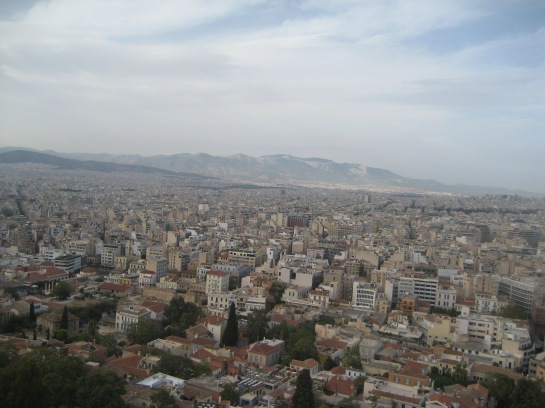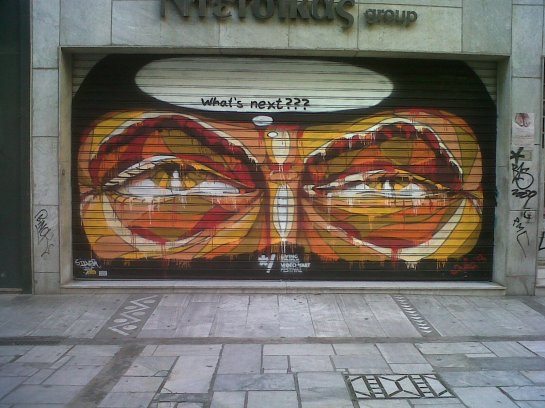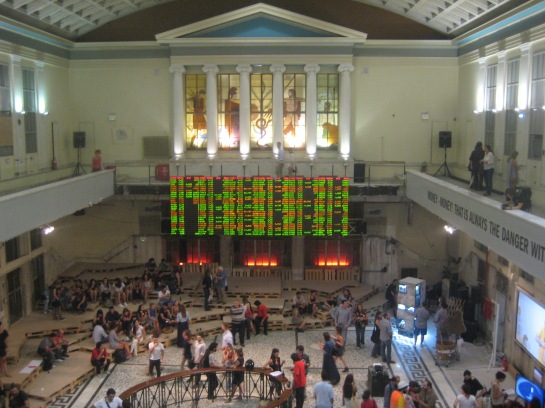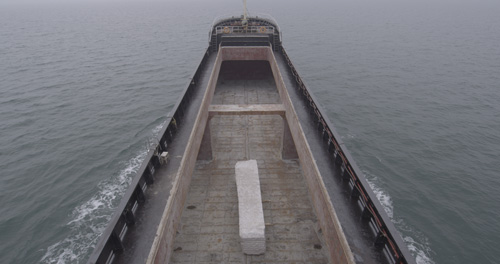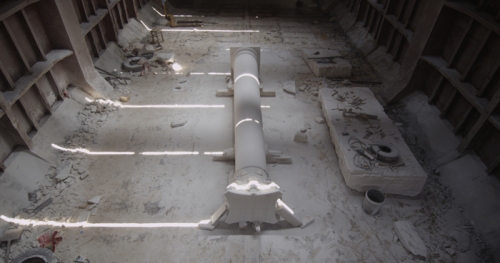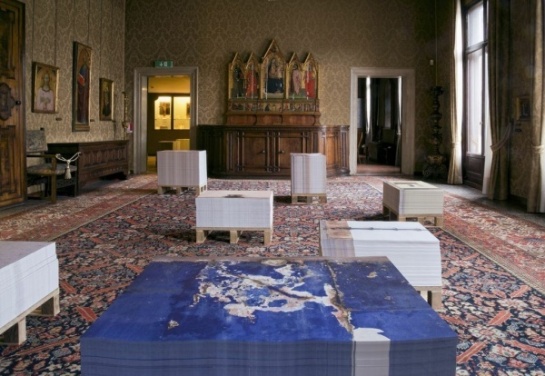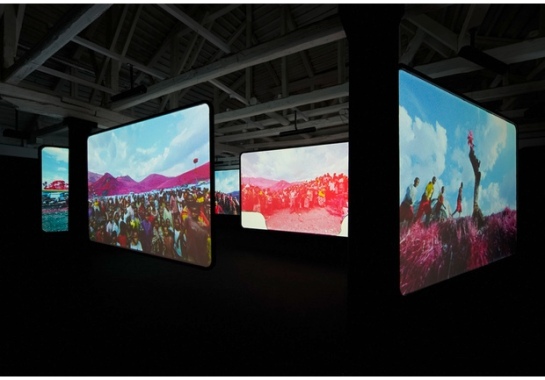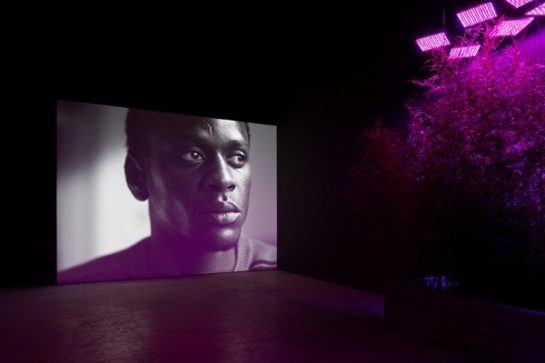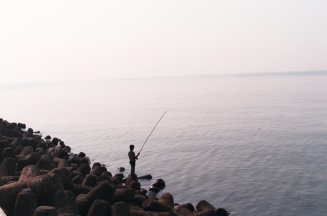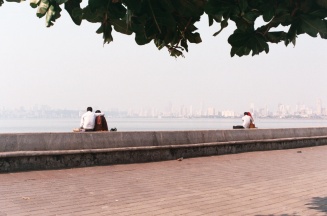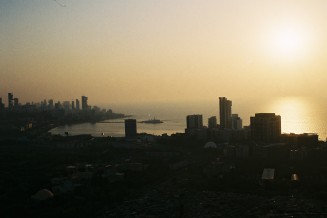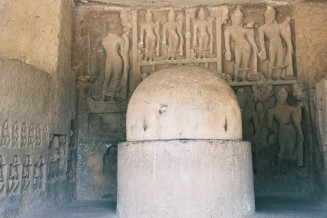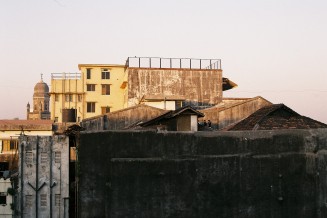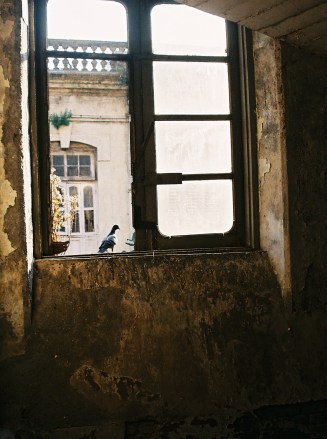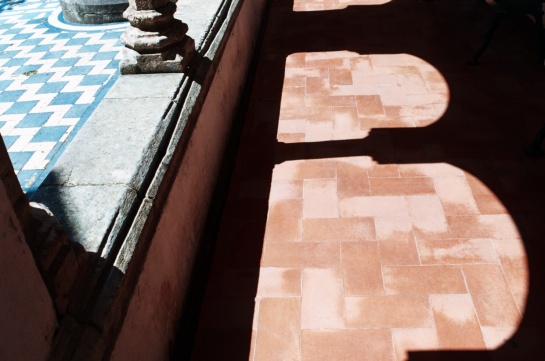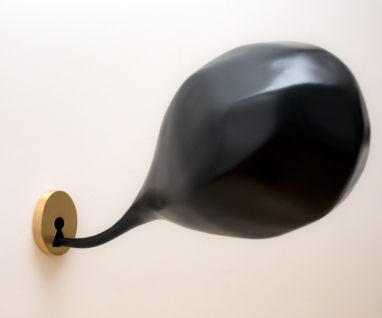This year’s Istanbul Biennial focuses on issues surrounding the power and struggles of public space, attempting to imagine concepts of democracy, freedom of expression, public and communal space and the relationship between urban transformation, art and politics. The title of the Biennial, ‘Mom, Am I Barbarian?’, taken from a book by Turkish poet Lale Müldür, explores the concept of the barbarian, which in Ancient Greek relates directly to ‘citizen’ and was applied to those who could not speak Greek. The Biennial questions what it means to be a good citizen today and looks at the idea of the barbarian in contemporary society as a marginalized or excluded citizen, someone trying to debunk the system, a revolutionary, or perhaps an artist.
The themes of the Biennial relate directly to issues arising in Turkey over the past several years, and which are common place in many of parts of the world. The Biennial focuses mainly on South America, Asia, the Middle East and North Africa, whilst putting recent events and artistic practice into context with modern history and artworks made in the 1960s and 70s in Europe and USA. It is impossible not to speak of the events that took place in Istanbul and across Turkey prior to the Biennial, in May and June, and the ongoing Gezi Resistance that has put into practice the Biennials entire concept and has, as a consequence, completely reshaped this years art festival. It’s these events which have also put the Biennial under controversy, following the Gezi Protests in Taksim, which ended in police brutality and forceful removal of protesters from public spaces, the Biennial organisers decided to pull out of using the much contested public spaces (Taksim Square, Gezi Park, Tarlabasi Bolevard etc.) which were originally planned as exhibition locations. Describing what was experienced in Istanbul and in cities across Turkey as “incomparable to any exhibition or art event”, the Biennial organisers decided that it felt wrong to negotiate with a government who was not even willing to listen to it’s own people, and moved the art festival to several indoor, private spaces and galleries within the city, with the exhibitions remaining ‘public’; free of charge to visitors. Whether this much debated decision was right or wrong, a festival about publicness moved out of the public sphere, the result of the Biennial is an extremely interesting, relevant and wide-ranging exploration of the global issues surrounding public space.
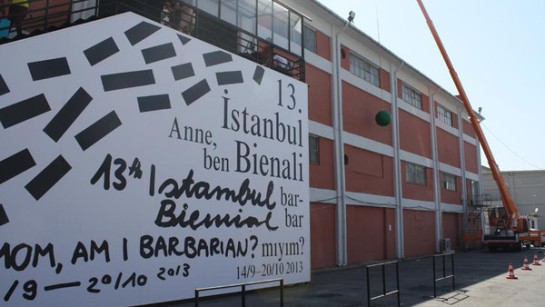
I will first mention the only piece of work that remains in the public domain in Istanbul which is Turkish artist, Ayşe Erkmen’s ‘Bangbangbang’. ‘Bangbangbang’, a green ball controlled by a construction vehicle, stands outside the main Biennial exhibition space, the Antrepo building, and swings inwards once every hour towards the building. The installation which doesn’t seem out of place in Istanbul – a city where new developments and construction sites are regularly springing up – immediately comments on this. However it’s not just a comment on redevelopment, but a reminder of the brutal destruction that takes place prior to this, highlighting the recent demolishing and gentrification of several neighbourhoods in the city. Most prominently, its position in front of the Antrepo building (which has traditionally been used as a Biennial venue), directly relates to the imminent destruction of the building itself, which has recently been sold to developers who will be redeveloping it into a hotel or another sort of building for commercial use. The swinging pendulum represents a ticking time bomb, counting down the building’s remaining lifespan for cultural purpose.
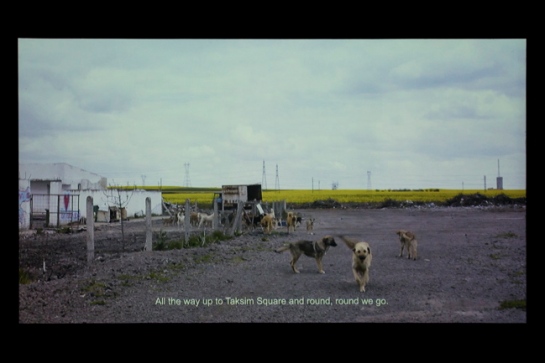
Alike ‘Banbangbang’ several of the works in the Biennial directly comment and reflect upon the current situation in Istanbul. One of these is Annika Eriksson’s short looped video work ‘I am the dog that was always here’ which focuses on the street dogs of Istanbul and offers the viewer a look at the affects of an expanding city. Set on the outskirts of Istanbul the video visually focuses on the street dogs who have been moved out of the centre by the authorities into a no mans land , meanwhile a voice over gives a tour of central locations; Taksim Square, Talabasi Boulevard and the Grand Rue de Pera which are contested sites undergoing development. Parallels can be drawn between the dogs and fate of citizens in these areas. The looping of the film provides repetition and a circular narrative enhances the ongoing nature of issue.
In another piece ‘Istanbul Diaries’, artists Elmgreen & Dragset enlist several young men to take part in a daily performance. Located in the Greek Primary School in a room full of lamp lit study desks the ‘performers’ visit each day to update their diaries. The diaries are left on the desks for visitors to read. The act of making the diaries public gives the men thoughts and opinions a public voice, which highlights issues of censorship and freedom of speech in contemporary Turkey.
Stepping outside of Turkey the Biennale explores similar issues in an international context. One piece that forms part of the exhibition is the video documenting the late Amal Kenawy’s performance ‘Silence of Sheep’ which took place in Cario, Egypt, in 2009. In this performance Kenawy led 15 people crawling on their hands and knees across a street, halting busy midday traffic. The video also documents the outrage of passers by who we see crowding around the artist questioning the performance’s validity as art, and her role in it as a woman, soon the argument gets out of hand and the police arrive. The controversial performance landed the artist along with most of the performers a night a jail and was pulled from the exhibition it was part of. Paradoxically, a year later documentation of the work was shown at the 12th International Cairo Biennial where it won the grand prize. The performance itself comments on the authoritarian system, poverty and powerlessness, however the unforeseen public reaction among other things raises crucial and ongoing issues in terms of public space in relationship with art, and social understanding and tolerance.
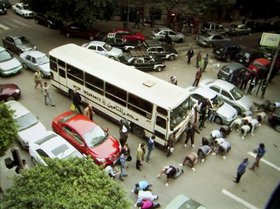
Another piece in the Biennial shows documentation of artist Fernando Piola’s attempted public art projects/interventions ‘Red Square Project’ and ‘Tutoia Operation’ planned for Brazilian neighbourhoods. Piola is interested in the contradictions and socio-political tensions that materialise in urban public spaces and his projects often address episodes in recent Brazilian history that have been neglected. In ‘Red Square Project’ Piola focused on a recently gentrified neighbourhood, his plan was to adjust the urban vegetation in the neighbourhood to create a reminder of both the former neighbourhood and of the repression that existed under military dictatorship. Unfortunately the project didn’t go ahead, the authorities denied permission. Instead Piola began ‘Tutoia Operation’, this time he introduces himself as a gardener, rather than an artist, planning to upgrade the neighbourhood. Under this guise the Piola was successful and, plant-by-plant, slowly replaced the green vegetation with red foliage.
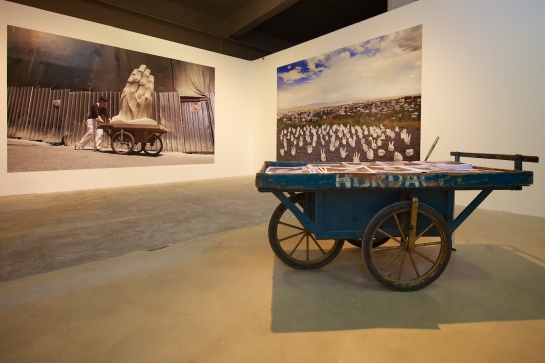
The concept of the monument in relation to publicness is explored in several works in the Biennial. Monuments are found in most cities, towns and landscape across the world, often large and sculptural and conceived for the purpose of remembering a person or an event of great historical, political or social importance. The ‘publicness’, ownership, limits of democracy and freedom of speech when it comes to creating national monuments is explored by artists Wouter Osterholt & Elke Uitentuis in their work ‘Monument to Humanity – Helping Hands’. This site-specific public project is based around the recent controversial story of the ‘Monument to Humanity’, which was created as a symbol of peace for Turkish and Armenian relations and as a reminder of the events which took place at the beginning of the 20th century. The monument, which stood on the Turkish/Armenian border in the city of Kars, displayed two figures with one extending a hand towards the other. The final part of the monument to be erected, the hand – was never attached, symbolising the demolishing of the monument before its completion after the Turkish PM President Erdogan visited the site and labelled the monument it as a ‘freak’. In their project ‘Helping Hands’ Osterholt and Uitentuis sought a way to record the public opinion on the issue, they wheeled a life size replica of the hand through the streets and asked for peoples views of the monument. These members of the public were then invited to cast their own hand in a position of their choice to symbolise their position on the subject. The result was 120 public hand casts, which became of temporary monument on a hillside in Kars, and a subsequent publication that documented the hands and reasons behind them.
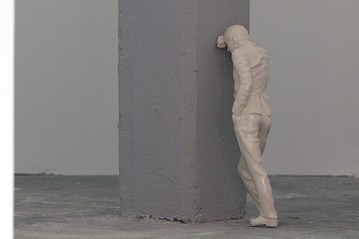
Mexican artist Gonzalo Lebrija’s sculpture ‘Lamento’, too explores the concept of the monument. ‘Lamento’ is a small white sculpture of a man leaning on his head on his arm which is raised in a position of sorrow. Originally conceived as a large scale monument specially for the city of Guadalajara in Mexico, the man represents sadness at the absurdity of mans modernisation of the city which led to the destruction and disregard for a lot of its important historical architecture. Unable to publicly realise this project Lebrija began to make and exhibit small replicas with the original intention of selling them through the private art market to fund the large scale statue. Lebrija eventually decided against the creation of a large statue, realising that it would become a monstrous addition to the cities surrounding modern buildings that the statue itself was mourning. In its small scale realisation ‘Lamento’ is a somewhat more powerful sculpture, capturing a moment of sadness between man and the world, the miniature man excerpts a monumental presence in the room, playing with the traditions and conformities of the size and scale of the ‘monument’. The idea that ‘Lamento’ can be replicated also presents the concept of a universal statue of sorrow whose relevance as appropriate in many cities globally as it is in Guadalajara.
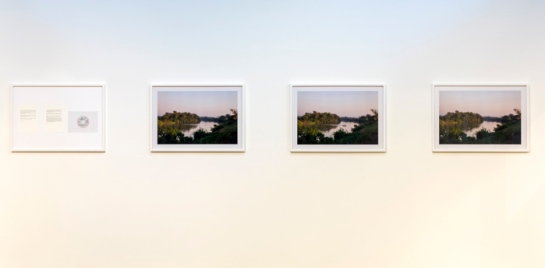
Some of the other memorable works for me in the Biennial reflect poetically upon its concepts. One of which is Frank Ortega’s ‘Music for a small boat crossing a medium sized river’. The story behind this piece is a short public boat journey crossing the Bobos River in Mexico. This short journey, duration only a couple of minutes, is taken by a number of local people daily, during which the boatman will play songs from a selection of CDs he has in the boat. Interested in the concept of this journey being accompanied by music and the fact that the journey was so short it was unlikely the full song would be heard, Ortega contacted musician Brian Eno asked if he would create a piece of music specifically for the journey. The song Brian Eno created was then put on to CD and given to the boat driver to keep in his collection of journey music. The work in the Biennial consists of a collection of photographs of showing the boat on its journey, framed letters to and from Brain Eno and a framed CD. Exploring the space between public and private, the beauty of this work lies in the fact that as the viewer you can not listen to the music, the resolution of the artwork only exists for the people who take the journey across the river if it happens to be chosen by the boatman during their journey.
Another piece focusing on music is Angelica Mesiti’s four-channel video piece ‘Citizens Band’ which documents the extraordinary performances of four different migrant musicians, exploring notions of migration, cultural ethnicity, performance in the public sphere and the unification of global citizens. Each player performs a distinct sound that reflects its cultural origin, however the public location of the performances reflect foreignness; a Cameroonian woman energetically beats out a rhythm in a Parisian swimming pool as if playing African drums; an Algerian man plays a Casio keyboard and sings using his voice in a melodic and emotionally stirring performance on the Parisian subway whilst fellow travellers look on, a Mongolian man sits on a Sydney street corner playing a horse head fiddle and throat singing as the world continues around him and a Sudanese taxi driver whistles a beautiful complex melody inside his car whilst the night time city traffic passes by. The videos are shot like portraits of the performers and for a few minutes the viewer is transported to their inner worlds. The short performances are shown on each screen in turn and culminate in one performance as the four surrounding screens transform into a blur of lights and an assemblage of sounds enveloping the viewer in a unique and beautiful audiovisual experience.
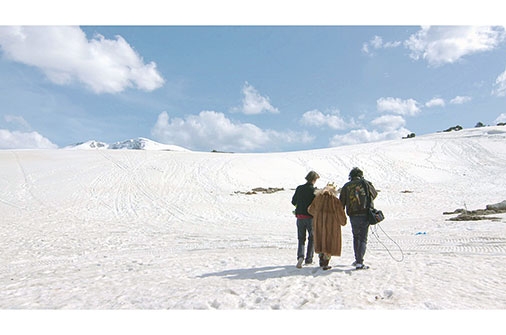 Finally I will mention ‘Violent Green’ a film made collaboratively by filmmakers Kaan Karachennem and Franz von Bodelschwingh with the Turkish poet Lale Müldür, of whom the Biennials title is borrowed from. The film, an experimental narrative, simultaneously acts as portrait, a social commentary and also even satire. Edited down from hours of footage, the resulting 20-minute film is a collection of bizarre and beautiful moments. The lines between filmmaker and subject are blurred and deconstructed, as both Kaan Karachennem and Franz von Bodelschwingh step into the cameras frame, in one scene we see one of them brushing poets hair, in another captured moment the three both supporting Lale as they attempt to walk across a snowy hill. Set in contemporary Istanbul and filmed mainly in a collection of public locations around the city, from the walk through Taxsim to an encounter by the Bosphorous, the scenes move in dreamlike sequence like a visual poem we are reminded simply of the poetry in the moment.
Finally I will mention ‘Violent Green’ a film made collaboratively by filmmakers Kaan Karachennem and Franz von Bodelschwingh with the Turkish poet Lale Müldür, of whom the Biennials title is borrowed from. The film, an experimental narrative, simultaneously acts as portrait, a social commentary and also even satire. Edited down from hours of footage, the resulting 20-minute film is a collection of bizarre and beautiful moments. The lines between filmmaker and subject are blurred and deconstructed, as both Kaan Karachennem and Franz von Bodelschwingh step into the cameras frame, in one scene we see one of them brushing poets hair, in another captured moment the three both supporting Lale as they attempt to walk across a snowy hill. Set in contemporary Istanbul and filmed mainly in a collection of public locations around the city, from the walk through Taxsim to an encounter by the Bosphorous, the scenes move in dreamlike sequence like a visual poem we are reminded simply of the poetry in the moment.
